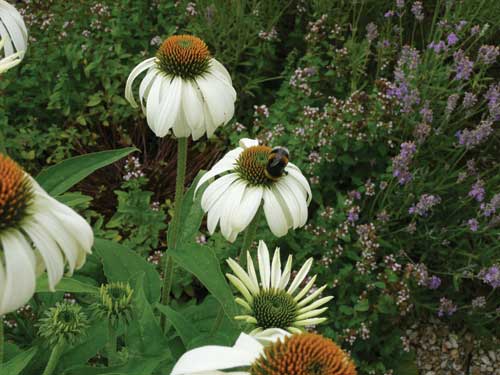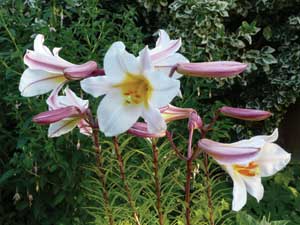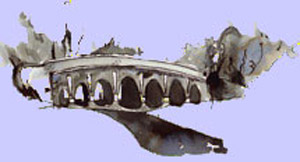However much you may think you have control over your garden, it is very much the weather which has the upper hand. This year, in particular, has been one of extremes. It started with heavy snow, the worst for 30 years we were told, and a prolonged cold spell. For weeks the temperature did not manage to struggle even as high as 5° centigrade and it seemed that spring would never arrive. Despite all the snow we have had a very dry first half of the year, breaking further records for dry starts to years, and then followed a dry, hot summer. All this, of course, has had varying, mostly adverse, effects on the garden.

White Echinacea
Spring bulbs, snowdrops, crocuses and daffodils were all up to 3 weeks later than in recent years. A clematis armandii which grows up the front of the house, and perfumes the garden entrance usually in late winter did not fully appear until early April. The yellow flowers of forsythia were also delayed and gave a very poor show. My winter jasmine which has not failed before, and usually always manages to brighten up a corner all winter with its yellow blooms, hardly flowered at all and seemed completely defeated by the weather conditions. Fortunately, however, I did not lose any plants to the harsh winter, all seem to have survived.
Once the warmer weather finally arrived, the garden got into its stride and by the end of April everything seemed to be trying to catch up, however my bearded irises which are a particular favourite were later than usual, but they also seemed to bloom for longer. As June arrived things seemed to be getting back to normal with what I rather grandly call my herbaceous border full of colour and plants back to their usual flowering times. By midsummer, in the balmy summer evenings, I could enjoy walking through from the back of the garden smelling the heady perfumes first of philadelphus, then passing on to summer jasmine covering a pergola, and on to honeysuckle climbing up the side and front of the house.
Then the hot, dry spell began to take its toll, and those plants waiting to give the borders splashes of later summer colour started to suffer. Monbretia which adds oranges and reds to brighten the later summer show is only flowering in more shaded parts, where it is in full sun has completely wilted and is dying down. Rudbekia, which I have in clumps all round the garden to bring colour into autumn, is also giving a very poor show and helenium ‘Lemon Queen’ is struggling to cope. My bearded irises which should be lifted and divided in July to improve next year’s show will have to wait until later as the ground is much too hard to dig into. Still, they should respond well to all the sun that they are getting.

Regal Lilies
There are, however, some plants which are thriving in this year’s conditions, a reflection of the climate they encounter in their natural habitat. Lavenders love the dry conditions, marjoram and thyme are flowering well and a white flowering echinacea is putting on a lovely show. Plants in the gravel garden are doing much better than those in the borders as the deep covering of gravel helps counteract the lack of water. Some plants in the herbaceous border do not seem to be affected at all by the lack of water. Echinops, hardy fuchsias, ice plant, penstemons, and fennel are all flowering well in the dry conditions. Lilies, which I have in pots, have given a good show, as has an agapanthus which is also in a pot. Tomatoes are thriving, and given the dry conditions hopefully blight will not be a problem this year. It may have been a year of extremes so far, but this all adds to the challenge and enjoyment of looking after a garden and makes each year different.
|




